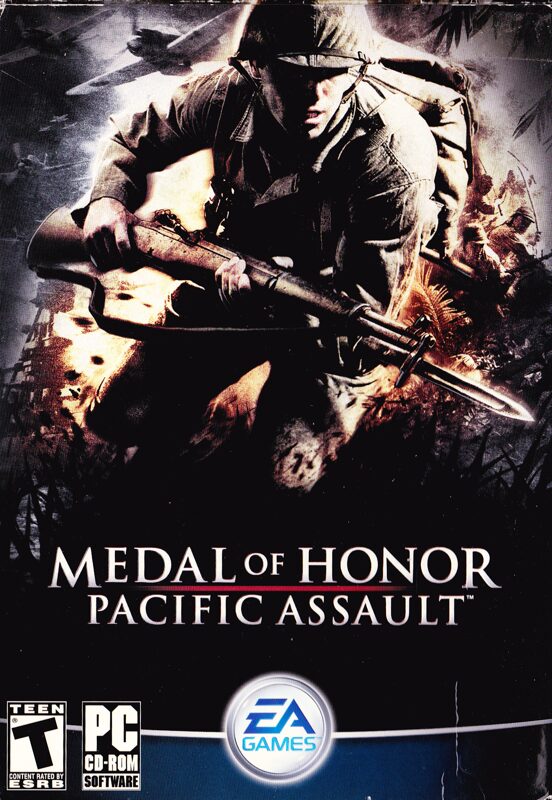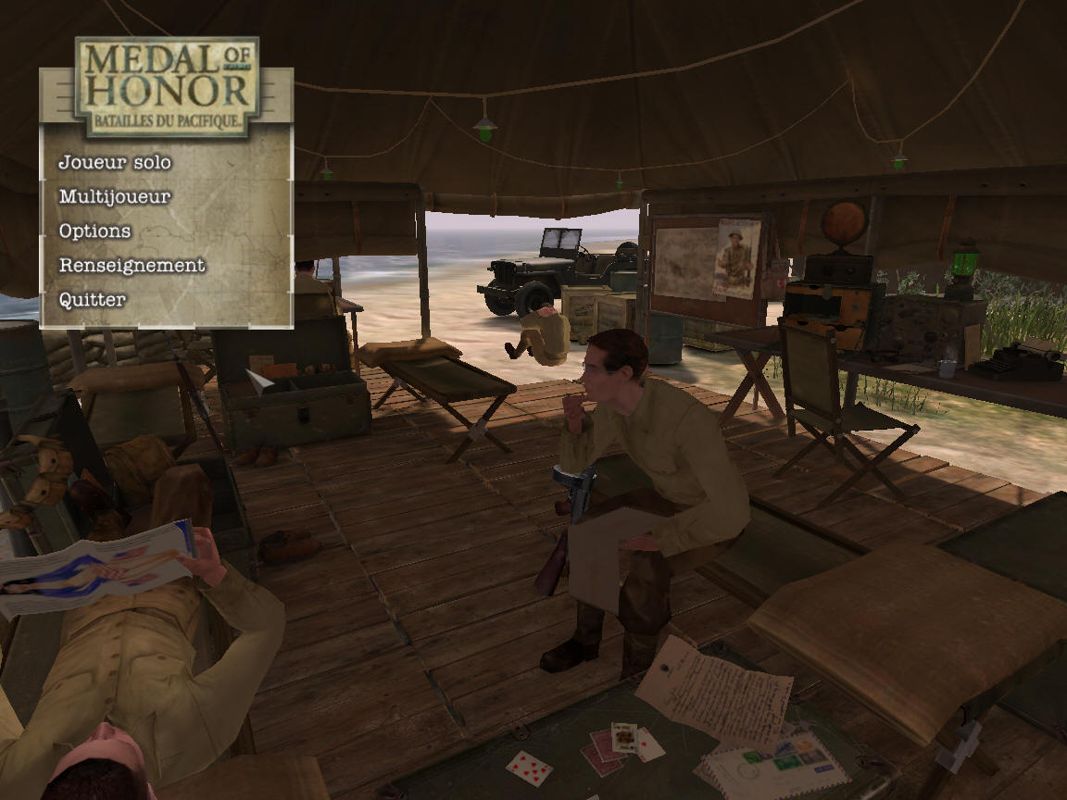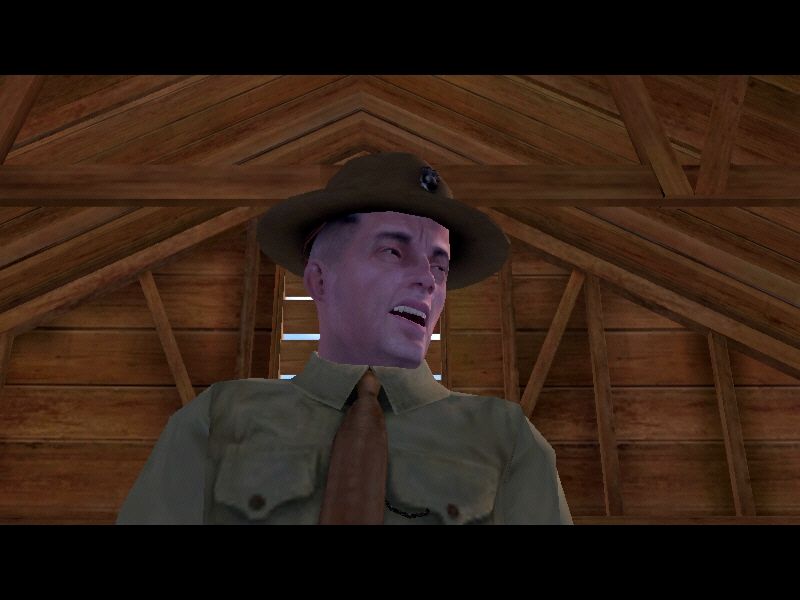Retro Replay Review
Gameplay
Medal of Honor: Pacific Assault delivers a surprisingly deep and varied single-player campaign that captures the raw intensity of World War II’s Pacific theatre. As the quiet, effective soldier Tommy Conlin, you’ll traverse lush jungles, storm enemy beaches, and infiltrate fortified positions. The level design balances linear, story-driven paths with occasional open battlefields that encourage tactical decision-making—whether you choose stealthy flanking maneuvers or a full-on frontal assault.
The game’s scripted sequences and on-rails moments feel lifted from a blockbuster war film, giving players dramatic set-pieces such as crossing razor-wire fields under fire or diving for cover as grenades rain down. Yet these cinematic flourishes never overwhelm the core shooting mechanics: your M1 Garand, Browning Automatic Rifle, and sniper rifle handle crisply, with satisfying recoil patterns and reload animations. Hidden objectives pepper each mission, rewarding exploration and replayability by unlocking additional stripes and medals.
Replayability is enhanced by the detailed statistics system, which tracks your headshots, suppressive kills, and overall accuracy. After completing a mission, you can jump back in to chase missed objectives or improve your time. While the AI occasionally displays pathing quirks—enemy soldiers sometimes hesitate when flanking—it generally reacts intelligently, seeking cover and coordinating attacks that keep firefights tense.
On the multiplayer front, Pacific Assault supports up to 32 players in classic modes like Team Deathmatch and Capture the Flag, alongside the new “Invasion” mode that challenges attackers to push through successive defensive lines. The maps, inspired by single-player locations, feel authentic and encourage combined arms tactics. The lack of modern perks keeps gameplay grounded and rewards raw shooting ability and map knowledge.
Graphics
For its era, Medal of Honor: Pacific Assault showcases lush, detailed environments that bring the Pacific islands to life. Towering coconut palms, thick underbrush, and shifting weather effects—like sudden rainstorms that wash mud over your uniform—contribute to an immersive atmosphere. Beach landings are truly memorable, with smoke, tracer fire, and landing craft textures that hold up surprisingly well even today.
Character models and animations, especially during scripted scenes, exhibit a high level of polish. Facial expressions during cutscenes convincingly convey fear, determination, and camaraderie. In combat, smooth weapon animations and dynamic muzzle flashes heighten the sense of urgency. While some textures can appear slightly blurry at higher resolutions, the overall art direction masks these minor issues with strong color palettes and cohesive design.
Particle effects are a particular highlight: explosions send debris flying realistically, and carefully placed ambient fog or haze deepens the jungle’s sense of mystery. Water effects during amphibious assaults showcase shimmering reflections and believable splashes. Performance remains stable on mid-range systems, and adjustable graphics settings allow players to fine-tune shadow quality, draw distance, and anti-aliasing to strike a balance between visual fidelity and frame-rate.
Story
Pacific Assault follows the journey of Private Tommy Conlin and his fellow Marines through the pivotal battles of the Pacific campaign, culminating with the assault on Tarawa Atoll in 1943. The narrative unfolds through the eyes of Conlin, who starts as a green recruit and evolves into a hardened soldier. Mission briefings and in-game dialogue flesh out the personalities of Conlin’s comrades: the no-nonsense leader, the educated corpsman, and the sharpshooter who provides crucial overwatch.
Emotionally charged set-pieces—such as rescuing wounded allies under heavy fire or witnessing the wreckage left behind by naval bombardments—underscore the human cost of war. The scripted approach pays off in moments like storming a pillbox or coordinating with a naval bombardment from offshore destroyers. These sequences are choreographed to foster an emotional connection between the player and the squad, making each firefight more than just a gameplay challenge.
Dialogue strikes a balance between period-appropriate military jargon and personal storytelling. As a result, characters feel like real people with hopes, fears, and humor, rather than generic soldier archetypes. While the overarching arc remains straightforward—advance island by island—the inclusion of hidden letters and diary entries adds depth and encourages players to explore every nook and cranny for additional lore.
Overall Experience
Medal of Honor: Pacific Assault stands out as one of the more cinematic and emotionally engaging World War II shooters of its generation. Its immersive environments, strong pacing, and well-crafted scripted moments deliver a memorable solo campaign that invites multiple playthroughs. The inclusion of hidden objectives and a robust statistics system ensures plenty of replay value for completionists.
Multiplayer remains a solid addition, even years after release. The new “Invasion” mode offers a fresh take on objective-based warfare, and the classic modes hold appeal for those who appreciate straightforward, skill-based matches. While the community has thinned over time, private servers and small-scale gatherings still keep the experience alive for dedicated fans.
Although a few rough edges persist—such as occasional AI pathfinding quirks and dated textures at higher resolutions—Pacific Assault’s strengths far outweigh its minor flaws. The game’s blend of intense combat, evocative storytelling, and authentic atmosphere makes it a must-play for fans of historical shooters and World War II enthusiasts alike. Whether you’re storming the beaches for the first time or returning for another attempt at perfecting your medal count, Medal of Honor: Pacific Assault remains a standout entry in the genre.
 Retro Replay Retro Replay gaming reviews, news, emulation, geek stuff and more!
Retro Replay Retro Replay gaming reviews, news, emulation, geek stuff and more!









Reviews
There are no reviews yet.